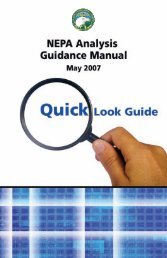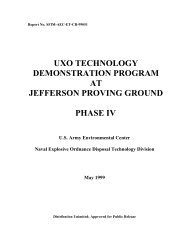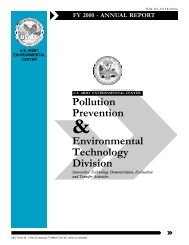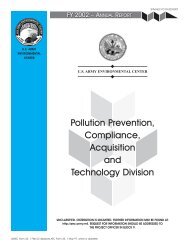(MRAP) Vehicle Program - U.S. Army Environmental Center
(MRAP) Vehicle Program - U.S. Army Environmental Center
(MRAP) Vehicle Program - U.S. Army Environmental Center
Create successful ePaper yourself
Turn your PDF publications into a flip-book with our unique Google optimized e-Paper software.
<strong>Army</strong> <strong>MRAP</strong> <strong>Vehicle</strong> <strong>Program</strong> <strong>Program</strong>matic <strong>Environmental</strong> Assessment December 2010<br />
1972 established that Federal agencies should comply with Federal, State, interstate,<br />
and local requirements requiring control and abatement of environmental noise to the<br />
same extent as private entities.<br />
The vehicles are required to meet the requirements of the CFR Title 49 Transportation<br />
Part 325, Compliance with Interstate Motor Carrier Noise Emission Standards. Appendix<br />
G contains a listing of exterior noise levels collected during testing of <strong>MRAP</strong> vehicles.<br />
The <strong>MRAP</strong>’s noise levels are comparable to the noise levels of the other military vehicle<br />
systems.<br />
Per AR 200‐1, the <strong>Army</strong>’s <strong>Environmental</strong> Noise Management <strong>Program</strong> (ENMP)<br />
incorporates and replaces the Installation Compatible Use Zone <strong>Program</strong> (ICUZ). The<br />
goals of the <strong>Army</strong>’s ENMP are to: (1) control environmental noise to protect the health<br />
and welfare of people, on‐ and off‐ post/Civil Works Facilities (CWF), impacted by all<br />
<strong>Army</strong>‐produced noise, including on‐ and off‐post/CWF noise sources; and (2) reduce<br />
community annoyance from environmental noise to the extent feasible, consistent with<br />
<strong>Army</strong> training and materiel testing activities.<br />
<strong>Army</strong> <strong>MRAP</strong> vehicles will be fielded to existing testing, training, and fielding sites which<br />
already house ground weapon systems including some or all of the following: Bradley<br />
Fighting <strong>Vehicle</strong>s, Stryker <strong>Vehicle</strong>s, Heavy Tactical Trucks, Medium Tactical Trucks, and<br />
Light Tactical Trucks. The noise related impacts from the <strong>MRAP</strong> are anticipated to be<br />
similar to these existing vehicles which have not shown a significant impact to the<br />
environment or the surrounding areas. The testing, training and fielding activities likely<br />
occur, or have occurred, in already developed areas and away from residential<br />
neighborhood. This reduces community annoyance and protects the welfare of the<br />
community. As a result, <strong>MRAP</strong> vehicles are expected to have a negligible impact on the<br />
surrounding areas’ noise levels. Therefore, no direct, indirect or cumulative impacts to<br />
noise levels are anticipated or have been reported for <strong>Army</strong> <strong>MRAP</strong> life‐cycle activities.<br />
Each training, testing and fielding facility is required to comply with the environmental<br />
impact analyses requirements of NEPA. Thus, personnel at <strong>Army</strong> installations are<br />
responsible to determine how <strong>MRAP</strong> fielding activities will impact their installation’s<br />
noise levels, if different than described above. A site‐specific NEPA analysis and<br />
documentation may be required to address <strong>MRAP</strong> activities that are determined to<br />
significantly increase noise generation or complaints. This could include encroachment<br />
by surrounding population areas where public aggravation would be an increased risk.<br />
JPO <strong>MRAP</strong> will provide any required and requested system information to the<br />
installation personnel in support of document development.<br />
5.7 Solid Waste<br />
UNCLASSIFIED 36







